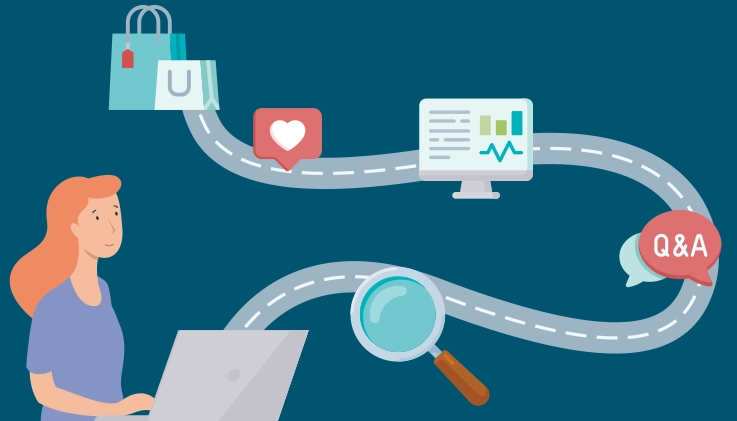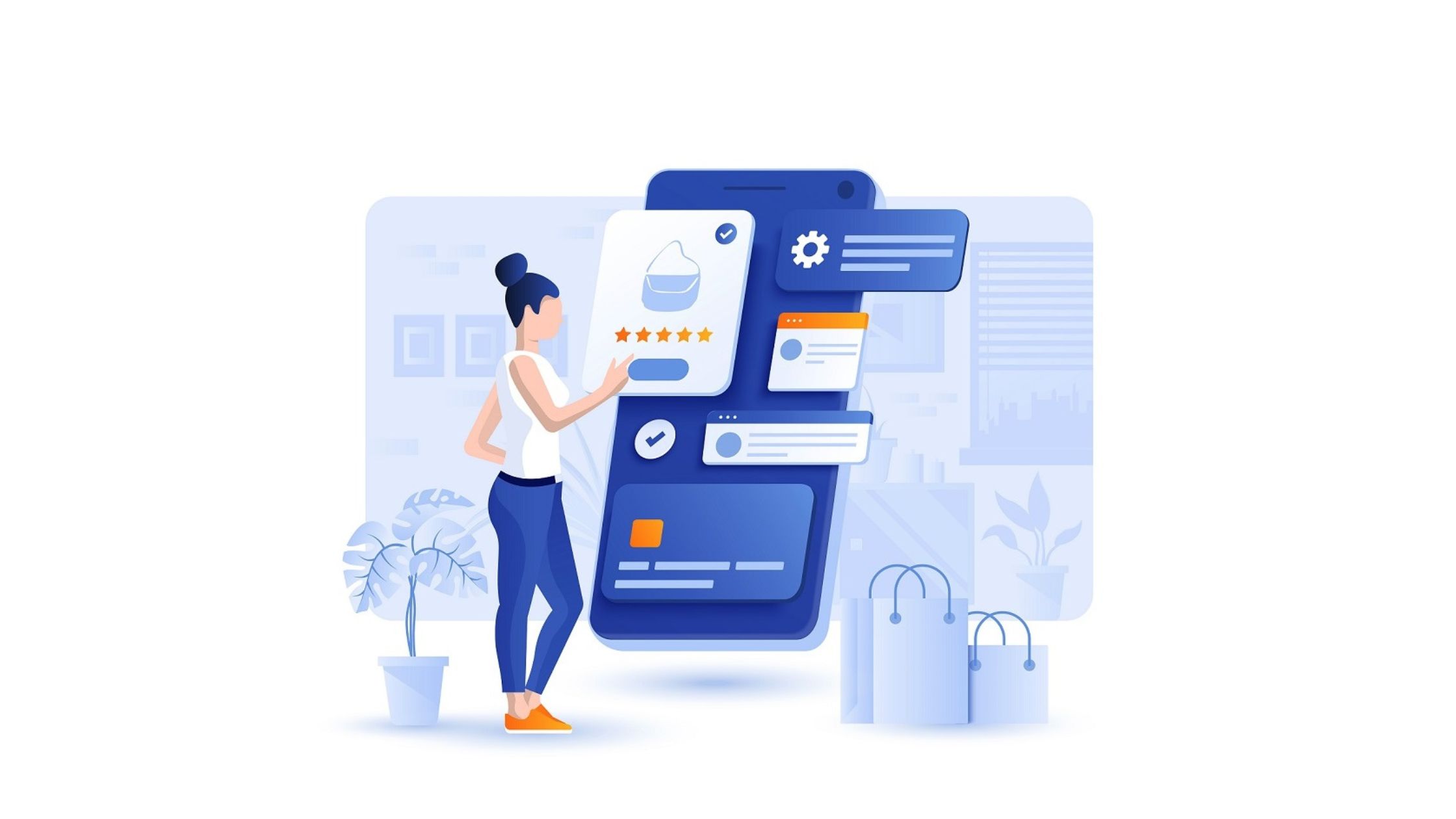E-Commerce Customer Journey: Stages, Mapping, And Tips On How To Build It
“ It’s not the destination, it’s the journey!” - Ralph Waldo Emerson.
“It is good to have an end to journey toward, but it is the journey that matters, in the end.” - Ernest Hemingway.
“Focus on the journey, not on arriving at a certain destination.” - Chris Hadfield.
The keyword in all these timeless quotes is the word “Journey!”
In the e-commerce world, there is only one journey that we never get bored of discussing, and that is the “e-commerce customer journey.” While the ultimate goal of any e-commerce business is to achieve conversions, boost sales, and increase revenues, it is pivotal to remember that the journey leading to that is as important as the destination.
In this article, we focus on the e-commerce customer journey and shed light on the different aspects of this topic. We start by defining the e-commerce customer journey and explaining its stages. We then discuss customer journey mapping and how to build a successful e-commerce customer journey map for online stores.
Table of contents:
- What is the E-Commerce Customer Journey?
- The Stages of the E-Commerce Customer Journey.
- Components of an E-Commerce Customer Journey Map.
- Tips on Building E-Commerce Customer Journey Maps.
What is the E-Commerce Customer Journey?
The e-commerce customer journey is defined as a series of stages potential customers go through in their relationship with an e-commerce store, starting when they hear about the store and begin interacting with it. In other words, the e-commerce customer journey is the complete experience of customers encompassing all the touchpoints and interactions they may have with the e-commerce brand.
The e-commerce customer journey has five main stages that we will tackle in the following section.
The Stages of the E-Commerce Customer Journey
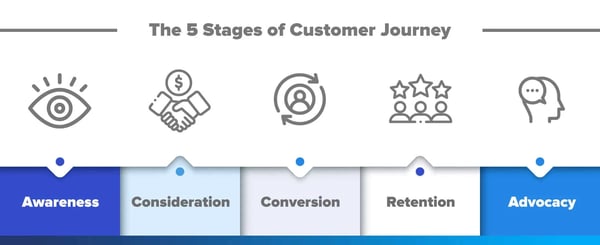 Image source: questionpro.com
Image source: questionpro.com
As mentioned, the e-commerce customer journey starts when a potential customer becomes aware of an e-commerce store and continues beyond purchasing. It is said to be a journey because there are steps between becoming aware and purchasing, and some additional steps even after that. It represents the complete customer-store interaction roadmap.
1- Awareness
The “Awareness” stage is the first step in the e-commerce customer journey. In this stage, potential customers hear about your e-commerce brand for the first time. They become aware of the existence of your online store and become familiar with the products or services you offer.
In this stage, you are mainly targeting people who:
- Haven’t heard about your e-commerce business before,
- may be interested in what it has to offer,
- and are starting to realize that they have a need they want to satisfy or a problem they want to solve.
The “Awareness” stage is the stage that paves the way for your entire e-commerce customer, so what you want to do here is increase the visibility of your online store and make it as attractive as possible to the target audience we just mentioned.
This stage is crucial because it is where customers formulate their first impressions about your e-commerce store.
2- Consideration
After the “Awareness” comes the “Consideration” stage. Here, potential customers, already aware of your e-commerce store, start developing an interest in your brand. They start exploring and evaluating your products or services and perceiving them as possible solutions to their problems.
This stage is crucial because it is where customers compare your products or services with other existing options in the market.
3- Conversion
Following the “Awareness” and the “Consideration” stages comes the “Conversion” stage. Some people also refer to this stage as the “Acquisition” or the “Purchase” stage. Whatever you may call it, it is the stage where customers take their interest in your products or services to the next level and decide to purchase from your online store.
The “Conversion” stage is where you start reaping what you sow. However, it is not the one where you stop “sowing” if you know what we mean.
This stage is crucial because it is the one that has the most direct effect on your conversion rates.
4- Retention
The “Retention” stage is the first post-purchase stage in the e-commerce customer journey. Some people call this stage the “Service” stage. It is the stage where you start focusing on nurturing the relationship you created with your customers throughout the three previous stages.
Remember when we said that you have to keep “sowing”? Well, here is where you do it. In other words, just because a customer purchased from your store and you got your conversion does not mean your role has ended. On the contrary, you need to double your effort to turn those customer relationships into long-term customer loyalty.
The retention stage is crucial because it is the one where you ensure that the customers who just purchased a product or subscribed to a service will keep coming back for more. This stage directly affects your customer's lifetime value and repeat purchase rate.
5- Advocacy
The “Advocacy” stage is an advanced phase in the e-commerce customer journey. It is the stage in which your customers go from merely satisfied customers to highly loyal advocates for your brand. In other words, in this stage, your customers, being extremely loyal to you, start enthusiastically advocating for your e-commerce store and promoting your products or services to their friends and family.
This stage is crucial because it encompasses word-of-mouth marketing and referral marketing, which contributes to expanding your customer base.
** Remark: Most people in the e-commerce business break down the customer journey into these five stages. However, you may find other people further dissecting the e-commerce customer journey, which results in more stages. For example:
- Interest: This can be a middle stage between the “Awareness” and the “Consideration” stages. It refers to being more than just aware of the e-commerce brand and its products/services, but less than considering buying anything. Usually, people include the step of a customer developing interest in the consideration stage; however, others perceive it as a separate phase.
- Intent/Decision: This can be a middle stage between the “Consideration” and the “Conversion” stages. People who include “Intent” or “Decision” in the e-commerce customer journey stages believe customers do not go from consideration to conversion right away.
In other words, during the “Consideration” stage, customers are still weighing their options, which means they’re still not ready to buy, while in the “Intent” stage, they are. Also, being “ready to buy” and “actually buying” are two different things; therefore, some people don’t include the customer’s intent in the conversion process.
- Loyalty: Some people include this as a stage in the e-commerce customer journey before the “Advocacy” stage. We know that for a customer to become an advocate for your brand, they have to be loyal first. Hence, there is a direction towards highlighting the significance of loyalty first and the efforts you need to exert to achieve that before discussing the possibility of advocacy.
Components of an E-commerce Customer Journey Map
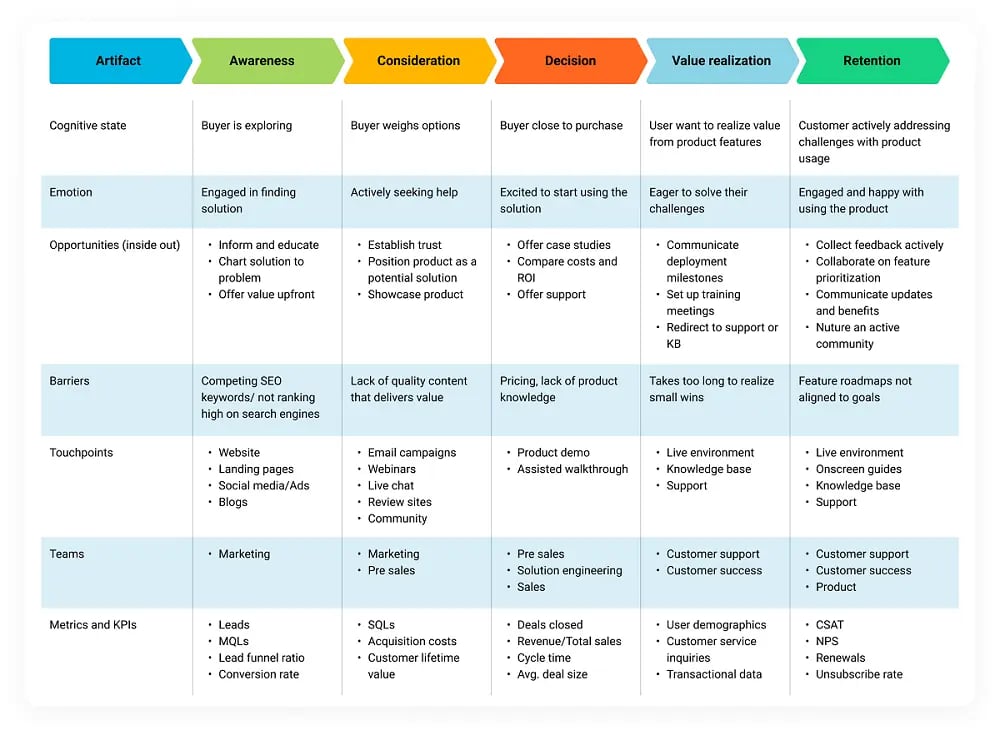 Image source: freshworks.com
Image source: freshworks.com
The process of building an e-commerce customer journey map is critical because such a map includes many components:
- Stages: This is the place on the map that indicates which stage of the journey the customer is currently at, whether it is awareness, consideration, conversion, retention, advocacy, or something in the middle.
- Touchpoints: Touchpoints are moments when an interaction happens between your customers and your online store. In other words, these are points where customers “touch” your e-commerce business in any way. The touchpoints can be your online store, social media accounts, social media ads, phone calls, or even physical store visits.
- Channels: The e-commerce customer journey map should also show the channels or platforms through which the touchpoints exist and the interactions happen.
- Customers: The map should also include vital information about the customers. For instance, it should mention:
- customers’ emotions,
- customer’s pain points, needs, and problems,
- and what customers are seeking to reach at each stage of the journey.
- Customer Personas: The e-commerce customer journey map can present all the customer data in the form of customer/buyer personas, which opens the door for more personalized strategies.
- Content: E-commerce customer journey maps also include the content and messaging that is most suitable for each stage.
- KPIs: Some e-commerce businesses include key performance indicators (KPIs) in the maps, which help track and evaluate the success of the customer journey.
You’ll find that the e-commerce customer journey map can take different forms, but they all have the same previously mentioned components. Here are a few examples of how e-commerce customer journey maps can look like:
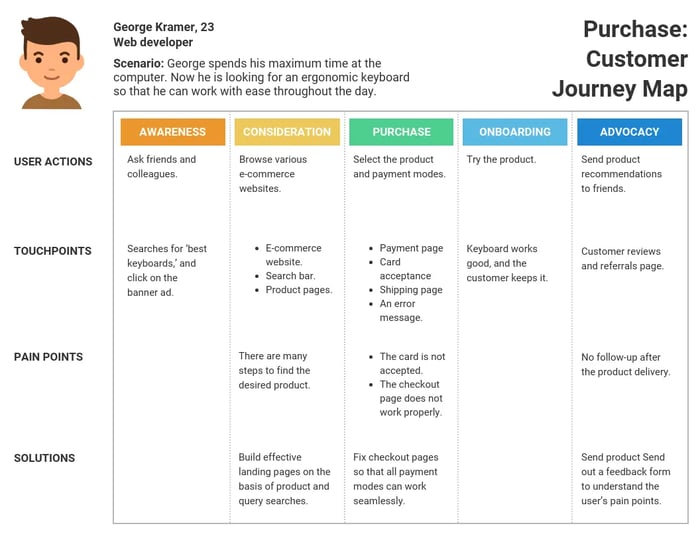 Image source: venngage.com
Image source: venngage.com
Tips on Building E-Commerce Customer Journey Maps
After getting to know the major components of an e-commerce customer journey map, you can now start mapping the journeys of your customers by following these tips:
- Identify your goals and objectives because knowing what you want to achieve will guide you throughout the process.
- Gather as much customer data and insights as possible because this will serve as a foundation for your customer journey maps. That should include all customers’ emotions, pain points, goals, and actions.
- Create customer personas with the help of proper customer segmentation, and keep in mind that every persona can have a unique journey.
- Identify all the existing touchpoints and channels early on in the process.
- Identify the most suitable visual format for your map, whether a flowchart, a table, or a diagram, and start inputting all the components in it.
- Test your maps and validate them using customer feedback to guarantee that they accurately represent the customers’ journeys.
- Remember that this is an ongoing process, so monitor your customer journey maps regularly and implement any required changes.
- Use automation tools to facilitate the process of building e-commerce customer journeys.
Speaking of automation, Converted.in offers a marketing automation tool that can:
- Automate customer segmentation, which will facilitate the process of creating customer personas for your customer journey maps.
- Gather all your customer data in one place like a hub.
- Facilitate touchpoints with your customers by automating social media ads and email marketing.
Book your demo now and start building your e-commerce customer journey today!
 By
By
